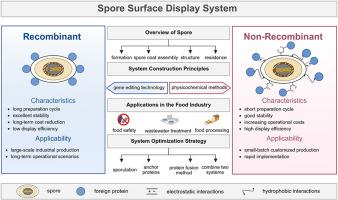用于食品工业酶稳定的细菌孢子表面显示系统:原理、应用和效率优化策略
IF 15.4
1区 农林科学
Q1 FOOD SCIENCE & TECHNOLOGY
引用次数: 0
摘要
酶是一种绿色生物催化剂,在食品工业中具有不可替代的作用。然而,游离酶面临着一些挑战,包括结构不稳定、不可逆的活性丧失和高生产成本,这些都限制了它们的工业应用。虽然目前使用磁性纳米颗粒、脂质体和金属有机框架的酶固定技术显示出前景,但它们遇到了诸如传质限制、酶活性损失和高制备成本等关键瓶颈。利用细菌孢子作为载体的细菌孢子表面显示系统(BSSDS)具有很强的稳定性,是一种很有前途的酶固定化平台。本文在系统阐述BSSDS基本原理的同时,全面分析了孢子形成和抗性机制。研究了重组和非重组系统构建原则,然后全面评估了目前BSSDS在食品工业中的应用,包括食品安全,废水处理和食品加工。对提高显示效率的各种优化策略进行了批判性评估,并讨论了该领域的新兴趋势,为工业规模的实施提供了见解。主要发现和结论该重组系统通过可重复使用提供了优越的长期稳定性和成本效益,这使其成为食品工业的有前途的候选者。通过系统的优化策略,提高了显示效率。这些技术创新使BSSDS成为一个越来越有前途的工业酶固定化平台,为食品工业提供可持续和经济高效的生物催化解决方案。未来的发展重点应放在多酶协同展示系统、可调控酶的智能响应载体、探索新型锚定蛋白等方面,进一步扩大可展示酶在食品工业中的应用范围和规模。本文章由计算机程序翻译,如有差异,请以英文原文为准。

Bacterial spore surface display system for enzyme stabilization in food industry: Principles, applications and efficiency optimization strategies
Background
Enzymes serve as green biological catalysts with irreplaceable roles in the food industry. However, free enzymes face several challenges, including structural instability, irreversible activity loss, and high production costs, which restrict their industrial implementation. While current enzyme immobilization technologies using magnetic nanoparticles, liposomes, and metal-organic frameworks show promise, they encounter critical bottlenecks such as mass transfer limitations, enzyme activity loss, and high preparation costs. Bacterial spore surface display systems (BSSDS) utilizing bacterial spores as carriers have emerged as a promising enzyme immobilization platform, offering enhanced stability.
Scope and approach
This review comprehensively analyzes sporulation and spore resistance mechanisms while systematically elucidating fundamental BSSDS principles. Both recombinant and non-recombinant system construction principles are examined, followed by a thorough assessment of current BSSDS applications in the food industry, including food safety, wastewater treatment, and food processing. Various optimization strategies for enhancing display efficiency are critically evaluated, and emerging trends in the field are discussed to provide insights for industrial-scale implementation.
Key findings and conclusions
The recombinant system provides superior long-term stability and cost-effectiveness through reusability, which positions it as a promising candidate for the food industry. Through systematic optimization strategies, advancements have been achieved in display efficiency. These technological innovations establish BSSDS as an increasingly promising platform for industrial enzyme immobilization, delivering sustainable and cost-efficient biocatalytic solutions to the food industry. Future development efforts should focus on multi-enzyme synergistic display systems, intelligent responsive carriers for controllable enzyme regulation, and exploring novel anchoring proteins to further expand the scope and scale of displayable enzymes across food industry applications.
求助全文
通过发布文献求助,成功后即可免费获取论文全文。
去求助
来源期刊

Trends in Food Science & Technology
工程技术-食品科技
CiteScore
32.50
自引率
2.60%
发文量
322
审稿时长
37 days
期刊介绍:
Trends in Food Science & Technology is a prestigious international journal that specializes in peer-reviewed articles covering the latest advancements in technology, food science, and human nutrition. It serves as a bridge between specialized primary journals and general trade magazines, providing readable and scientifically rigorous reviews and commentaries on current research developments and their potential applications in the food industry.
Unlike traditional journals, Trends in Food Science & Technology does not publish original research papers. Instead, it focuses on critical and comprehensive reviews to offer valuable insights for professionals in the field. By bringing together cutting-edge research and industry applications, this journal plays a vital role in disseminating knowledge and facilitating advancements in the food science and technology sector.
 求助内容:
求助内容: 应助结果提醒方式:
应助结果提醒方式:


